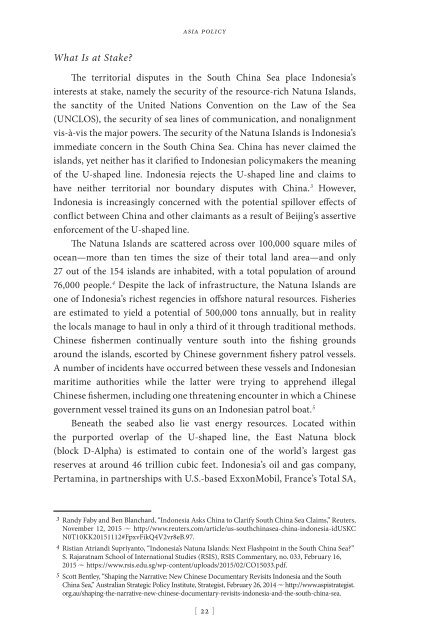Create successful ePaper yourself
Turn your PDF publications into a flip-book with our unique Google optimized e-Paper software.
asia policy<br />
What Is at Stake?<br />
The territorial disputes in the South China Sea place Indonesia’s<br />
interests at stake, namely the security of the resource-rich Natuna Islands,<br />
the sanctity of the United Nations Convention on the Law of the Sea<br />
(UNCLOS), the security of sea lines of communication, and nonalignment<br />
vis-à-vis the major powers. The security of the Natuna Islands is Indonesia’s<br />
immediate concern in the South China Sea. China has never claimed the<br />
islands, yet neither has it clarified to Indonesian policymakers the meaning<br />
of the U-shaped line. Indonesia rejects the U-shaped line and claims to<br />
have neither territorial nor boundary disputes with China. 3 However,<br />
Indonesia is increasingly concerned with the potential spillover effects of<br />
conflict between China and other claimants as a result of Beijing’s assertive<br />
enforcement of the U-shaped line.<br />
The Natuna Islands are scattered across over 100,000 square miles of<br />
ocean—more than ten times the size of their total land area—and only<br />
27 out of the 154 islands are inhabited, with a total population of around<br />
76,000 people. 4 Despite the lack of infrastructure, the Natuna Islands are<br />
one of Indonesia’s richest regencies in offshore natural resources. Fisheries<br />
are estimated to yield a potential of 500,000 tons annually, but in reality<br />
the locals manage to haul in only a third of it through traditional methods.<br />
Chinese fishermen continually venture south into the fishing grounds<br />
around the islands, escorted by Chinese government fishery patrol vessels.<br />
A number of incidents have occurred between these vessels and Indonesian<br />
maritime authorities while the latter were trying to apprehend illegal<br />
Chinese fishermen, including one threatening encounter in which a Chinese<br />
government vessel trained its guns on an Indonesian patrol boat. 5<br />
Beneath the seabed also lie vast energy resources. Located within<br />
the purported overlap of the U-shaped line, the East Natuna block<br />
(block D-Alpha) is estimated to contain one of the world’s largest gas<br />
reserves at around 46 trillion cubic feet. Indonesia’s oil and gas company,<br />
Pertamina, in partnerships with U.S.-based ExxonMobil, France’s Total SA,<br />
3 Randy Faby and Ben Blanchard, “Indonesia Asks China to Clarify South China Sea Claims,” Reuters,<br />
November 12, 2015 u http://www.reuters.com/article/us-southchinasea-china-indonesia-idUSKC<br />
N0T10KK20151112#FpxvFikQ4V2vr8eB.97.<br />
4 Ristian Atriandi Supriyanto, “Indonesia’s Natuna Islands: Next Flashpoint in the South China Sea?”<br />
S. Rajaratnam School of International Studies (RSIS), RSIS Commentary, no. 033, February 16,<br />
2015 u https://www.rsis.edu.sg/wp-content/uploads/2015/02/CO15033.pdf.<br />
5 Scott Bentley, “Shaping the Narrative: New Chinese Documentary Revisits Indonesia and the South<br />
China Sea,” Australian Strategic Policy Institute, Strategist, February 26, 2014 u http://www.aspistrategist.<br />
org.au/shaping-the-narrative-new-chinese-documentary-revisits-indonesia-and-the-south-china-sea.<br />
[ 22 ]


